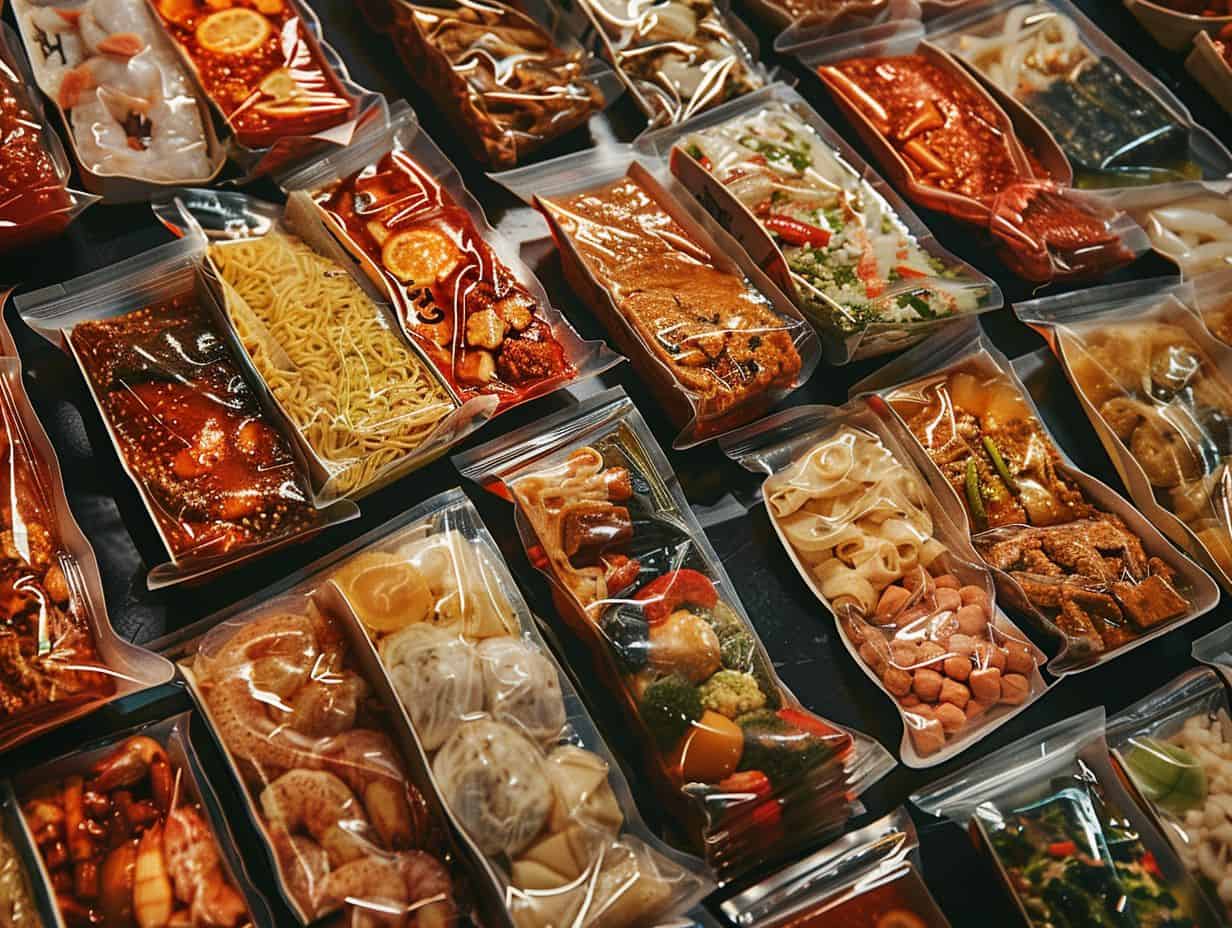Interested in the various MRE flavor profiles from around the world? Each region, including American, Asian, European, and Middle Eastern, presents distinctive tastes and ingredients.
Exploring the significance of customizing MRE flavor profiles, the methods involved, and the advantages it offers. Understand how cultural preferences, dietary constraints, and ingredient accessibility influence the creation of delightful and fulfilling meals for individuals in varied regions.
What are the Different MRE Flavor Profiles?
MREs, short for Meals Ready-to-Eat, offer a diverse range of flavor profiles to cater to various tastes and preferences. These flavor variations are influenced by regional cuisine, culinary traditions, and cultural nuances.
These regional influences can be seen in the choice of ingredients, with each MRE highlighting the culinary heritage of its place of origin. Whether it’s the fragrant spices of South Asian dishes or the hearty stews of Eastern Europe, traditional foods play a significant role in shaping people’s taste preferences. Creating a well-balanced flavor in these meals requires skillful blending of ingredients to deliver a cohesive gastronomic experience that appeals to consumers from different backgrounds.
1. American MREs
American MREs offer a blend of traditional flavors and modern culinary techniques that reflect the diverse tastes and preferences of the American populace.
These Meals Ready-to-Eat showcase the rich culinary heritage of regions across the United States, utilizing local ingredients to capture the essence of each area. From the savory BBQ-inspired dishes of the Southern states to the hearty chilis of the Midwest and the fresh seafood creations on the coastal regions, American MREs are a vibrant tapestry of flavors. The flavor customization in MREs allows for personalization, catering to individual preferences while still celebrating the collective melting pot of American cuisine.
2. European MREs
European MREs feature a diverse range of flavor profiles influenced by long-standing culinary traditions, varied taste preferences, and precise seasoning techniques. The blending of different gastronomic traditions from across Europe has led to a multitude of taste perceptions found in these Meals Ready-to-Eat. Each region’s culinary legacy is evident in the thoughtfully prepared dishes, providing a well-balanced mix of flavors that appeal to a wide range of palates. From the hearty stews of Eastern Europe to the delicate pastries of France, each meal captures the essence of European cuisine. Exploring these MREs offers not only a culinary experience but also a journey into the heart of European gastronomy.
3. Asian MREs
Asian MREs offer a sensory journey through the vibrant and aromatic flavors of ethnic cuisine, characterized by meticulous ingredient selection and culinary techniques.
These ready-to-eat meals encapsulate the essence of Asian gastronomy by harmoniously blending traditional dishes with modern convenience. Culinary pairings in Asian MREs often highlight the delicate balance of sweet, savory, sour, and spicy notes, creating a symphony of flavors that cater to diverse palates. The flavor variations in each meal reflect the region’s rich culinary heritage, showcasing a fusion of age-old recipes and innovative adaptations. Through cultural integration, these MREs not only nourish the body but also provide a window into the diverse and dynamic food culture of Asia.
4. Middle Eastern MREs
Middle Eastern MREs offer a variety of flavors that reflect the culinary heritage of the region. These flavors are characterized by spice blends and intricate flavor combinations.
The uniqueness of Middle Eastern MREs stems from the tradition of enhancing flavors with spices like sumac, za’atar, and cumin, which give traditional dishes a distinct aroma and taste. These MREs combine savory and sweet flavors, demonstrating culinary finesse in each bite. By pairing ingredients like tahini, pomegranate molasses, and rose water, the complexity and richness of flavors are heightened, showcasing the diverse gastronomic richness of Middle Eastern cuisine.
Why is Tailoring MRE Flavor Profiles Important?
Customizing MRE flavor profiles is important to accommodate diverse cultural preferences, enhance culinary experiences, and create a harmonious blend of flavors that appeal to individual taste preferences. By tailoring MRE flavor profiles, food manufacturers can bridge gaps between different culinary backgrounds, enabling individuals to enjoy familiar tastes even in unconventional meal settings. Flavor adaptation plays a significant role in promoting cultural diversity through food, highlighting unique ingredients and traditional recipes from various regions.
Through taste infusion techniques, MREs can be transformed into a fusion of flavors that provide sustenance and reflect the diverse array of global cuisines. Recognizing the significance of culinary sensitivity is essential in developing MREs that not only provide nourishment but also uplift spirits by offering a comforting, personalized dining experience.
1. Cultural Preferences

Cultural preferences have a significant impact on the flavor profiles of MREs, reflecting the diverse culinary traditions, taste preferences, and gastronomic heritage of various regions.
The interaction between cultural sensitivity, culinary adaptation, and flavor profiling adds depth to the variety of MRE offerings.
The unique food traditions and flavor profiles of each region influence the choice of ingredients, spices, and cooking methods used in MREs, ensuring that the meals appeal to the palates of those who consume them.
By recognizing and integrating these cultural subtleties, MRE providers can develop tailored culinary experiences that cater to a range of tastes and preferences, providing a taste of home even in challenging environments.
2. Dietary Restrictions
Considering dietary restrictions is crucial when tailoring MRE flavor profiles to accommodate various nutritional needs, promote better health outcomes, and ensure culinary inclusivity.
When developing MREs, taste creation is key to ensuring that the flavors are appealing to a wide range of palates. By carefully selecting ingredients and focusing on flavor balance, the meals can not only meet dietary requirements but also be enjoyable to eat. Nutritional considerations are vital for maintaining the health and well-being of individuals, making it essential to incorporate essential vitamins and minerals while keeping calorie counts in check. Customizing culinary offerings to include options for individuals with allergies or dietary preferences fosters a sense of inclusivity and respect for diverse dietary needs.
3. Availability of Ingredients
The tailoring of MRE flavor profiles is influenced by the availability of ingredients, emphasizing the use of local produce, unique seasonings, and fresh ingredients to elevate the culinary experience.
By incorporating locally sourced ingredients, MREs can embody the essence of the region, showcasing diverse flavors and culinary traditions. Seasonal produce introduces a dynamic aspect, ensuring that each meal is not only flavorful but also in harmony with the time of year. Region-specific seasonings are key in bringing authenticity to the dishes, underscoring the cultural significance associated with the flavors.
This focus on ingredient selection and culinary ingenuity not only improves the taste of MREs but also provides consumers with a more engaging dining experience.
How are MRE Flavor Profiles Tailored?
Creating MRE flavor profiles is a detailed process that involves integrating culinary techniques, balancing flavors, and considering cultural preferences to craft a sensory culinary experience that appeals to a variety of tastes.
Culinary pairing plays a crucial role in this process, as different flavors must harmonize and enhance each other. Through extensive experimentation with flavors, chefs can refine each MRE dish, taking into consideration the subtleties of taste preferences among consumers. By incorporating elements from various cuisines, such as spices, herbs, and cooking methods from different regions, MRE flavor profiles are enhanced, providing a diverse range of flavors that cater to a broad spectrum of palates.
1. Research and Development
Research and development play an important role in customizing MRE flavor profiles, driving culinary innovation, and improving flavor profiles to align with changing consumer preferences.
By exploring culinary creativity and flavor profiling, food scientists and chefs work together to push the boundaries of taste experiences. The heart of culinary development involves the precise process of experimentation, where a variety of ingredients are creatively combined to produce unique and memorable flavors. Through ongoing exploration and fine-tuning, the customization of MRE flavor profiles evolves into an artistic endeavor that engages the senses and enhances dining experiences for a broad audience, showcasing the dynamic evolution of flavor enhancement in the contemporary food industry.
2. Collaboration with Local Suppliers
Working with local suppliers is essential for customizing MRE flavor profiles through the procurement of fresh, high-quality ingredients, encouraging culinary collaboration, and backing local food sustainability.
This collaboration not only guarantees the integration of culinary traditions into MRE recipes but also enables the utilization of special local ingredients that contribute unique flavors. By closely partnering with local suppliers, military food developers can craft MREs that reflect regional culinary characteristics, fostering a feeling of comfort and recognition for the troops. The incorporation of sustainable sourcing practices also improves flavor cohesion by emphasizing environmental consciousness, community welfare, and ensuring long-term food security.
3. Focus Groups and Taste Tests

Engaging focus groups and conducting taste tests are important steps in customizing MRE flavor profiles to align with various palate preferences, promote culinary exploration, and gather valuable feedback for flavor adjustments.
By analyzing taste sensitivity in these focus groups, food developers can gain a better understanding of the subtleties of flavor preferences and make informed modifications to meet consumer expectations.
Through culinary experimentation and thorough taste testing, MRE manufacturers can adjust their products to cater to a wide range of tastes, ensuring that each meal is enjoyable and fulfilling.
The sensory feedback received from these sessions allows for ongoing improvements and the tailoring of MRE offerings based on real-world consumer reactions, contributing to overall customer satisfaction and product quality.
What are the Benefits of Tailoring MRE Flavor Profiles?
Customizing MRE flavor profiles provides several advantages, including enhanced taste and satisfaction, improved cultural understanding, and a stronger connection to culinary heritage and traditions.
By adjusting the flavor profiles of MREs, individuals can enjoy a more personalized dining experience that reflects their specific preferences. This flexibility in flavors caters to a variety of tastes and allows for innovative culinary combinations that highlight the diverse range of global cuisines.
Through this customization, individuals can participate in a culinary exchange, exploring new flavors and dishes that deepen their understanding of different cultures. This not only enriches the dining experience but also helps preserve and celebrate traditional culinary practices for future generations.
1. Improved Taste and Satisfaction
Customizing MRE flavor profiles can enhance the taste and satisfaction of meals, resulting in a well-balanced flavor combination that improves the overall dining experience and adds unique taste elements.
By adjusting MRE flavor profiles, individuals can create a harmonious blend of taste sensations that cater to their specific preferences. The incorporation of a variety of flavors not only excites the taste buds but also enhances the overall dining enjoyment.
By carefully considering flavor variety and taste perception, the culinary experience can become a sensory adventure filled with pleasant surprises. The art of customizing flavors goes beyond simple food preparation; it turns meals into engaging experiences that stimulate all the senses, making every bite a moment of delightful enjoyment.
2. Better Nutrition and Health Outcomes
Customizing MRE flavor profiles can have positive effects on nutrition and health outcomes. This can be achieved by being mindful of individual taste preferences and utilizing innovative culinary techniques. Tailored MRE flavors aim to enhance the dining experience for individuals with specific dietary requirements, offering balanced food pairings and meeting diverse dietary needs.
Incorporating a variety of herbs, spices, and seasonings not only improves the taste of MREs but also ensures that individuals receive a well-rounded nutritional intake. By understanding the science behind flavor enhancement, it becomes possible to create tasty and nutritious meals that cater to various dietary restrictions and preferences. This approach ultimately contributes to improved health outcomes.
3. Enhanced Cultural Understanding and Collaboration
Customizing MRE flavor profiles can encourage cultural understanding and collaboration by honoring culinary identity, supporting flavor personalization, and embracing the range of global cuisine.
Offering a selection of customizable flavors that represent various culinary backgrounds, MREs create a unique space where individuals from different cultures can exchange their culinary heritage and experiment with flavors. The option to tailor MREs based on cultural importance not only showcases the diversity of culinary traditions but also nurtures an appreciation for the intricacies and variations in different cuisines.
Through cross-cultural culinary encounters facilitated by personalized MREs, individuals have the opportunity to experience new flavors, textures, and scents, promoting a deeper connection and understanding of the diversity in global cuisine.
Frequently Asked Questions
What are MRE flavor profiles?

MRE flavor profiles refer to the different taste profiles that are incorporated into MREs (Meals Ready to Eat) to ensure they are appealing to individuals from different cultural backgrounds.
Why is it important to tailor MRE flavor profiles for different cultural preferences?
It is important to tailor MRE flavor profiles for different cultural preferences because taste is closely linked to cultural identity and individuals may have different expectations and preferences when it comes to food.
How are MRE flavor profiles tailored for different cultural preferences?
MRE flavor profiles are tailored by incorporating ingredients and flavorings that are commonly used in the specific cultural cuisine. This can include different spices, herbs, and cooking techniques.
Can MRE flavor profiles be customized for individual preferences?
Currently, MRE flavor profiles are tailored for different cultural preferences at a broader level. However, in the future, there may be options for individuals to choose their preferred flavor profiles from a variety of options.
What are some common regional variations in MRE flavor profiles?
Some common regional variations in MRE flavor profiles include Asian, Middle Eastern, European, and Latin American profiles. These profiles may differ in terms of spiciness, sweetness, and overall flavor profile.
Do MRE flavor profiles affect the nutritional value of the meals?
No, MRE flavor profiles do not affect the nutritional value of the meals. The same nutritional content is maintained in all MREs, regardless of the flavor profile. However, some cultural variations may include different types of ingredients, which may alter the nutritional composition slightly.


